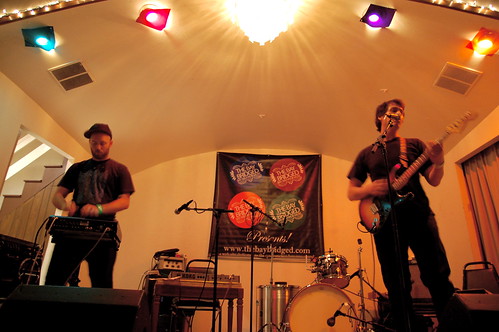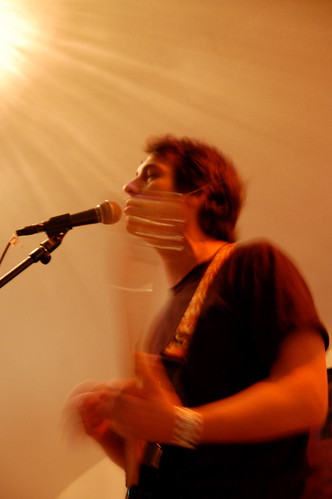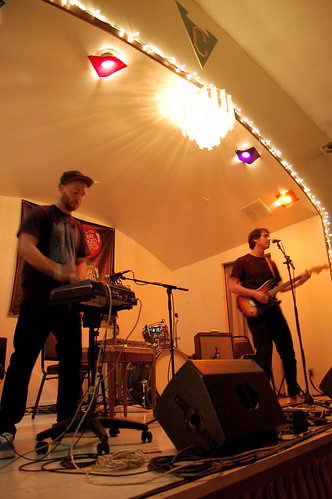 Exray's, a San Francisco duo, opened The Bay Bridged Benefit Concert on July 23rd also featuring Man/Miracle, John Vanderslice, and Thao Nguyen. Exray's music is an intriguing combination of inventive songwriting and beat-heavy sound collage. We caught up with members Jon Bernson and Michael Falsetto-Mapp after their set to talk about their process, in and out of the studio. Check out their song "Everything Goes," featured on In A Cloud: New Sounds from San Francisco, a comp with other noteworthy SF bands.
Exray's, a San Francisco duo, opened The Bay Bridged Benefit Concert on July 23rd also featuring Man/Miracle, John Vanderslice, and Thao Nguyen. Exray's music is an intriguing combination of inventive songwriting and beat-heavy sound collage. We caught up with members Jon Bernson and Michael Falsetto-Mapp after their set to talk about their process, in and out of the studio. Check out their song "Everything Goes," featured on In A Cloud: New Sounds from San Francisco, a comp with other noteworthy SF bands.
HAD: You guys come from different scenes, Michael as a DJ/ producer, predominantly involved with Hip-Hop. Jon, you've been a songwriter for quite awhile. How does that influence your collaboration as Exray's and bring different influences to your music?
M: Right now some of my influences are J Dilla, Flying Lotus, Mike Slott, and Broadcast. But growing up my Mom and Dad were really into Soul and Jazz: Al Green, James Brown, Herbie Hancock, but also stuff like Talking Heads, Kraftwerk and The Art of Noise. I didn't grow up listening to a specific genre. My mom used to teach dance classes and she would play Prince, Michael Jackson and all types of dance music. As a DJ, I look for songs I like, it doesn't really matter what genre. When I met Jon, he slipped me one of his CDs and I really got into the songwriting, the way he wove together songs and stories. He found a way to tell the story of a fictional place, make it feel real, and at the same time, write about different times in history.
J: For me, lyrical ideas can come from anywhere, past present, future, but I feel like an insect when it comes to musical inspiration. What affects me most comes from my immediate environment; Michael and the other people I create with. Approaching a blank canvas with another person and figuring out how to go forward is what opens me to new ideas. I don't want to come off like I'm immune to the work of famous artists, because that's not the case at all, but my antenna react most strongly to what's right next to me.
HAD: You've said that a lot of your music has been influenced by life on 24th street in San Francisco's Mission District. It's clear that in recent years, the Mission has been gentrified. Are you providing commentary on this? What themes are you exploring in your music?
J: We have hours of recordings taken right outside my door. I've lived in the same place at 24th and Bryant for quite sometime. When we first moved in, Michael DJed our first party and some fights broke out after a gang showed up.
M: They were pissing in his plants.
J: The neighborhood was a lot more wild. I feared it and loved it. And up until the last five years, it had this real night and day kind of vibe. During the day, all Latino families with strollers and laundry baskets, and at night, gangs, homeless people and hospital outpatients. Whatever I write about in the future, I'll always connect to the Mission material because it represents an unforgettable time and place.
 HAD: For a duo, you guys have a strong dynamic range. Can you tell us about your sound layering process both live and when making records?
HAD: For a duo, you guys have a strong dynamic range. Can you tell us about your sound layering process both live and when making records?
M: Our recorded songs are pretty layered, and for our live show we've broken it down to the key elements. When we started out, I was using a program for DJs called Serato, so it was all our music, but it wasn't 100% live. I would do melodic scratching, trick-mixing, essentially using the turntable as an instrument. As Exray's, we wanted to step with a different show. All live, using no drum loops or pre-recorded material.
HAD: So what do you play? Because a lot of people at the show were asking. What equipment are you using?
M: It's an Akai MPC 2000XL. The acronym stands for: 'MIDI Production Center'. It's basically a tool that allows you to sample sounds, then chop them up and assign them to pads. Then you play the pads with your fingers, like an instrument. Most musicians who have them use it in the studio to multi-track. Most hip-hop is made on some kind of drum machine, or a computer program that has functions similar to a drum machine. But it’s the same concept. You have a machine that enables you to trigger sounds and record the patterns your playing.
J: Yeah, most people use it as a studio tool, not for shows, but we got to a point where we realized it would be perfect for our live set.
M: This dope producer Exile, from LA, is doing it. He’s definitely been a influence for me to do everything live, as well as Jel from Subtle and Themselves.
J: We have a much more organic chemistry now. The tempo can speed up and slow down according to what the song or the moment demands, whereas before with Michael on turntables, we were pretty much locked into a particular tempo. We put a lot of attention into the sounds we make, so another thing we like about the MPC is that Michael can play like 10 custom drum kits in the same show. He gets on one and when the song is over, he moves over and gets on a different drum set.
HAD: Are you bringing 10 guitars with you too?
J: For now I'm trying to bring variety to the set by writing different types of songs, in different styles, lyrics, and ways of using my voice. I want Exray's to begin with the most direct arrangements we can come up with, and focus on bringing the songs to life as immediately as we can. The records focus more on our sound aesthetic and a type of expression that can only happen in the studio. The more I see and play live shows, the more I identify with the physical experience that gets transferred from the people onstage to the audience.
M: We want the to songs provide a strong foundation for the live show, but aren't interested in replicating our records.
J: You know, like holding ourselves hostage in our own house.
M: That's not our goal when we play live. Bringing energy and intensity to the music is most important to us.
J: On our records, we try to make the most of the studio environment. It's something we've devoted ourselves to for awhile now. We haven't played a live show in two years, but we haven't been idle. We've spent hours and hours recording, learning how to use the studio as an instrument, and trying to make that instrument our own.
 HAD: On these anticipated records you have coming out, we heard that you collaborated with some pretty diverse artists: Nate Query (Decemberists), Tim Cohen (the Fresh & Onlys),Warren Huegel (Jonas Reinhardt), Dominic Cramp (Evangelista) and Jason Kick (Maus Haus). As a duo do you feel like it's a lot easier to expand your palette and work with other artists?
HAD: On these anticipated records you have coming out, we heard that you collaborated with some pretty diverse artists: Nate Query (Decemberists), Tim Cohen (the Fresh & Onlys),Warren Huegel (Jonas Reinhardt), Dominic Cramp (Evangelista) and Jason Kick (Maus Haus). As a duo do you feel like it's a lot easier to expand your palette and work with other artists?J: Honestly, the Verdi club was our first real show as Exray's, so we see the live act as an unwritten book. So far, it feels great to play as a duo. At this show, we were able to collaborate with Jason from Maus Haus. We rehearsed with Jason as much as it felt natural and that ended up being two songs. He was great, but we might never play a show with him again, or maybe he'll play a whole set with us sometime? It feels good to have that flexibility. Another thing is that we were packing up our stuff to come to the gig and when we were done, we looked down and all our gear could have fit on a motorcycle. We were ready for the road. Simplicity gives room to roam.
HAD: You guys do a lot of sampling. What are some of your favorite found sounds? Sounds you like in everyday life. Things in your environment that inspire you?
J: Audio illusions, sounds that confuse or challenge your mind to study them in order to figure out what they are. Acousmatic sounds, sounds from concealed sources.
M: We're both into that concept. John Cage and Musique Concrete are influences of ours, especially in the studio.
J: Pierre Shaeffer and Chance Music.
M: Beautiful accidents. We take a lot of inspiration from them when we're recording. A lot of times we're sampling ourselves and rehashing it somehow. Looking for moments that could never be repeated.

HAD: When can our readers get wind of you in NYC? Do you have any tours in the works?
J: We plan to be there in October, when our EP comes out on Howells Transmitter.
HAD: We're looking forward to it!






0 comments:
Post a Comment